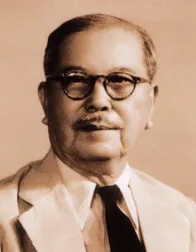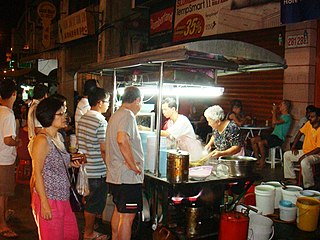Related Research Articles

Tan Kah Kee was a Chinese businessman, investor, and philanthropist active in Singapore and the Chinese cities of Hong Kong, Shanghai, Xiamen, and Guangzhou.

Nanyang University (Chinese: 南洋大学; pinyin: Nányáng Dàxué, also known as Nantah, was a university in Singapore between 1956 and 1980. During its existence, it was Singapore's only private university in the Chinese language. In 1980, Nanyang University was merged with the University of Singapore to form the National University of Singapore. It was only until 2005 that another private school in Singapore, SIM University, was established.

Chinese Singaporeans are Singaporeans of Chinese descent. Chinese Singaporeans constitute 75.9% of the Singaporean citizen population according to the official census, making them the largest ethnic group in Singapore.

The Cheng Hoon Teng Temple is a Chinese temple practising the Three Doctrinal Systems of Buddhism, Confucianism and Taoism located at No. 25 Jalan Tokong, Malacca City, Malaysia. It is the oldest functioning temple in the country.

Tan Kim Seng, was a prominent Straits-born Chinese merchant and philanthropist in Singapore in the 19th century.
Tan Sri Datuk Amar Ong Kee Hui was a Malaysian Chinese politician and founder / President of the Sarawak United People's Party. His family trace their origins to Longhai, Fujian Province, China.
Sir Song Ong Siang was a lawyer and active citizen of the British Crown Colony of the Straits Settlements. He was an ethnic Hokkien as well as a third generation Hokkien Peranakan Baba Chinese with ancestry from Zhangzhou in Minnan region, and the first ever Asian in Singapore to be knighted. Song was noted for his contributions to the development of the Singapore civil society, and was held in esteem throughout the Colony.

Singapore Hokkien Huay Kuan (SHHK), or the Singapore Hokkien Association in English, is a cultural and educational foundation. It was established in 1840 to promote education, social welfare and the preservation of the Chinese language and culture among Chinese Singaporean and other Overseas Chinese groups in Southeast Asia. As of 2014, the SHHK, which has 5000 members, is the largest clan association in Singapore.
The Bujang Lapok film series consists of five comedy films:
- Bujang Lapok (1957)
- Pendekar Bujang Lapok (1959)
- Ali Baba Bujang Lapok (1960)
- Seniman Bujang Lapok (1961)
- Bujang Lapok Kembali Daa (1986)

Penangite Chinese are ethnic Chinese Malaysians of full or partial Chinese ancestry who either hail from or live within the State of Penang. As of 2020, nearly 45% of Penang's population belonged to the Chinese ethnic group, making ethnic Chinese the largest ethnic community within the state.
Kapitan China Ong Tiang Swee,, CSS known as the Grand Old Man, was a renowned businessman and philanthropist in Sarawak. Regarded as the most prominent and successful Chinese community leader in Sarawak, he was Kapitan China of Sarawak and President of the Chinese Chamber of Commerce, as well as an advisor on Chinese Affairs and confidant to Rajah Charles Brooke. He was also the first Chinese nominated to the Sarawak Council Negri in 1937. He played a significant role in the progress of the state and saw Sarawak through its infant stages of development.

Kapitan China Ong Ewe Hai, (1830–1889) was a prominent businessman and community leader in Sarawak.
See Ewe Lay, alternatively spelled Seet Ewe Lay, was a descendant of the wealthy Peranakan See clan and the founder of Lat Pau, the first major Chinese newspaper in Singapore.

Low Kim Pong, was a prominent Chinese trader in Singapore. He was a leader of the Hokkien community in Singapore.
Goh Siew Tin, alias Goh Tat Pang, was a prominent Chinese merchant. He was the first president of the Singapore Chinese Chamber of Commerce, and was known as the founder of Batu Pahat, Johor.
Tan Seng Poh, was a chairman of the Singapore Municipal Committee, a Justice of the Peace and an honorary magistrate.
Sing Po, was a Chinese-language newspaper in Singapore. The newspaper was the second Chinese-language daily newspaper in Singapore, after Lat Pau. The newspaper closed down in 1898 was replaced by the Jit Shin Pao a year later.
Yeh Chih Yun, also known as Ye Mao Bin, Ye Ji Yin, Yong Wen, Ting Song Lu Shi Sun and Xing Er Sheng, was a Chinese newspaperman and poet. He was the Chief Editor of Lat Pau, the first major Chinese newspaper in Singapore.

Look Yan Kit was a Cantonese dentist who came to Singapore in 1877 and found great success, having several high profile clientele. He was a millionaire.
References
- 1 2 3 4 5 Chong, Guang Kwa; Bak, Lim Kua (2019). A General History Of The Chinese In Singapore. World Scientific. p. 853. ISBN 978-9813277656.
- 1 2 3 "See Hoot Kee". Reference@NLB. Singapore: National Library Board . Retrieved 18 June 2022.
- 1 2 Chong, Guang Kwa; Bak, Lim Kua (2019). A General History Of The Chinese In Singapore. World Scientific. p. 136. ISBN 978-9813277656.